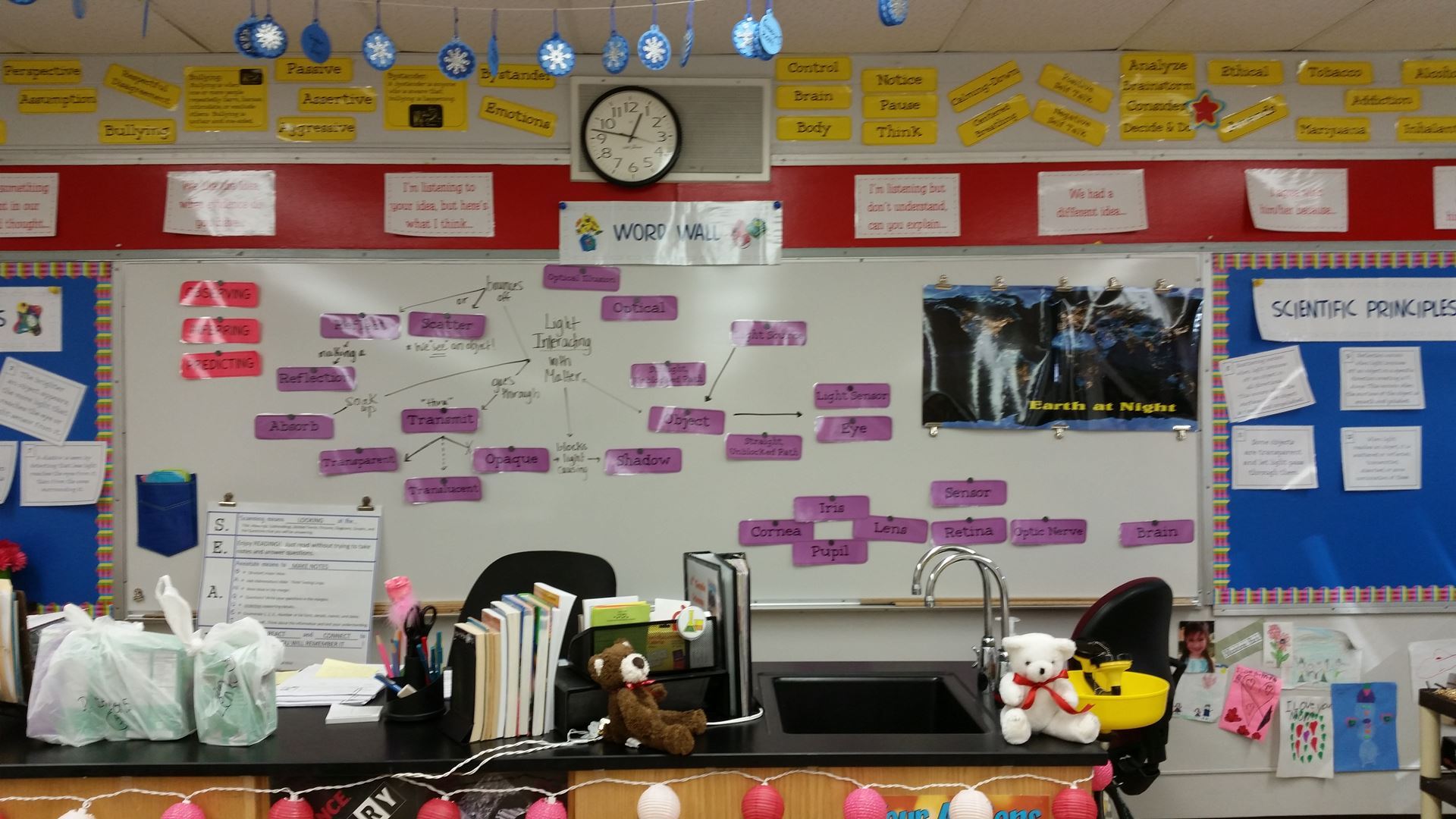What is a word wall?
Reading Rockets defines a word wall as a collection of words which are displayed in large visible letters on a wall, bulletin board, or other display surface in a classroom. The word wall is designed to be an interactive tool for students and contains an array of words that can be used during writing and reading.
A vocabulary acquisition tool, word walls are used in conjunction with other strategies to build academic vocabulary. By displaying high frequency words, students have a visual tool to help them articulate words in discussion, reading, and writing.
What role do word walls play in an NGSS science classroom?
With the shift to student-centered, three-dimensional learning, there is a great need for students to acquire and use scientific academic vocabulary. In order for students to engage in discussion, draft scientific explanations, and obtain, evaluate, and communicate information, students must understand core ideas and have a command of the related scientific vocabulary. Word walls, when used in tandem with three-dimensional learning, promote vocabulary acquisition.
How are word walls used in the NGSS classroom?
While there are various methods of using word walls, making word walls an effective tool in the NGSS classroom can be accomplished using these guidelines.
- Find a location in the classroom to create the word wall. Consider a bulletin board, whiteboard, or chart paper. As seen below, magnets can be used to attach the words and the whiteboard can be used to write connections between words on the word wall.
- Determine a method for displaying the words. From sticky notes to sentence strips to templates, the possibilities are endless. Select a method that works in your classroom and your budget.
- Develop a plan for adding words to the word wall. Consider the following questions: Will students and teachers add words to the wall? How often will words be added to the word wall? Will illustrations also be included with the words? Will the wall be interactive and allow for examples to be included?

-
Discuss the word wall and the plan with your students. Over the years, the word wall has become an integral part of tracking understanding. To accomplish this task, we only introduce words to the wall once the student scientists already understand the concepts.
-
-
I explain the process to the students: Scientists, we are going to be investigating many different phenomena. Along the way, we will make many discoveries. We will keep track of our discoveries using a few tools in the classroom. One tool is the word wall. On this wall, we will keep track of all the scientific words that relate to our discoveries. That way, when we are discussing, writing, or reading, we can always reference the word wall. I would like your help in deciding when we should add a word to the wall. And, we can write on the wall or add examples when we feel that will help us keep track of our learning.
-
For example, the student scientists had been investigating how light interacts with objects and were focusing on how "see through" objects worked. The students designed an investigation to test various objects to determine what was happening to the light using a flashlight and light sensor. After investigating, student groups concluded that "see through" objects allowed a great deal of light through the object, while other objects did not let any light through, and some objects allowed some light through but were not "see through." After discussing their data and reaching consensus, I introduced the words that other scientists use to describe those different types of objects as transparent, opaque, and translucent. We added these words to the wall and added our descriptions of the word. Students then attached various materials to the cards - plastic wrap, wax paper, and aluminum foil.

- Support student vocabulary acquisition with other strategies. For example, when we add words to the word wall, we also record these words in student vocabulary notebooks. Students use spiral bound note cards and follow a procedure for adding words to their notebooks. Younger students may have a journal to draw a picture of the word or attach examples. Using online portfolios such as Seesaw also allow for students to track their understanding.
NGSS + Word Walls = Student Engagement
Word walls are an excellent tool to support students in the classroom. And, students can use these tools as they write, read, and discuss science. I have often observed students look towards the word wall in discussion to find the word they are searching for in their minds. Having this reference at the ready allows for students to engage in discussion and supports their thinking.


.jpg) Aimee Park, ISTA Director of Professional Learning, is a professional learning facilitator and sixth grade science teacher. Making sense of the Next Generation Science Standards with her own students and colleagues, Aimee has witnessed students engage in learning as scientists. Sharing her experiences, she has worked with K -12 educators, administrators, and professional learning providers to bring the Next Generation Science Standards to life for student scientists in classrooms across Illinois.
Aimee Park, ISTA Director of Professional Learning, is a professional learning facilitator and sixth grade science teacher. Making sense of the Next Generation Science Standards with her own students and colleagues, Aimee has witnessed students engage in learning as scientists. Sharing her experiences, she has worked with K -12 educators, administrators, and professional learning providers to bring the Next Generation Science Standards to life for student scientists in classrooms across Illinois.
If you have any questions regarding the information shared in these blogs, contact Aimee at: istaprofessionallearning@gmail.com